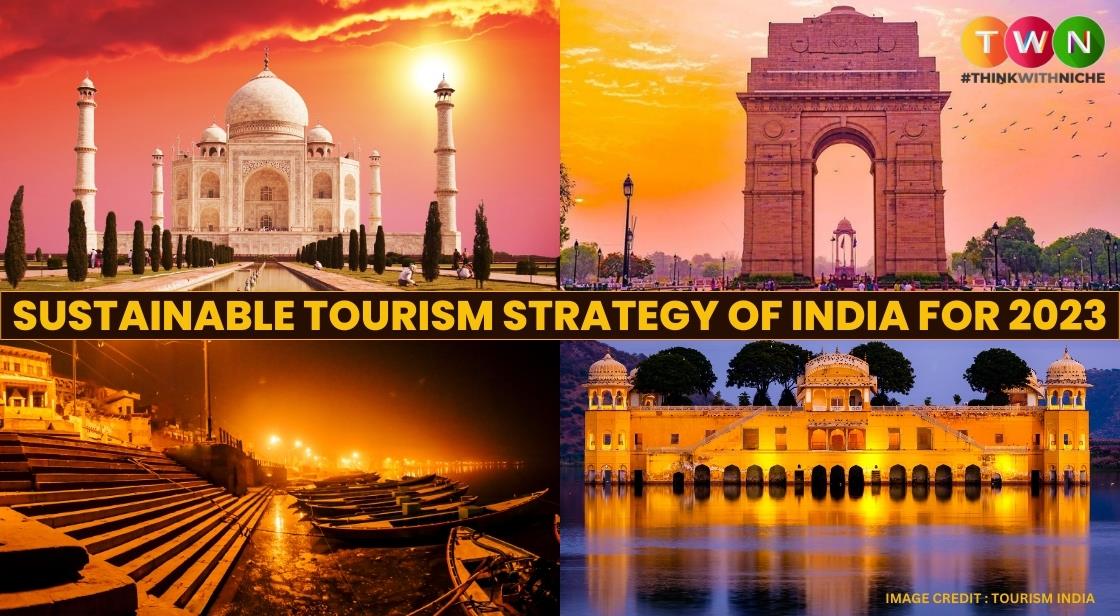Explore the Sustainable Tourism Strategy of India for 2023

Blog Post
A key pillar of the Make in India initiative is the Indian tourist industry. India's tourism sector is a major economic multiplier and is becoming more and more important as the country strives for rapid economic growth and employment creation. One of the industries that employ the most women is the tourism industry.
India provides diverse geographical regions, world-class tourist attractions, and specialized travel services including ecotourism, adventure travel, and medical travel. Incredible India has encouraged growth in employment and tourist arrivals. India wants to raise the number of passenger traffic from the current 0.4 million to 4 million. The economic potential of cruise tourism is anticipated to increase from $110 million to $5.5 billion over the next few years.
The growth of infrastructure with multiple uses, such as hotels, resorts, and restaurants, as well as transportation infrastructure (airports, highways, ships, and railroads), is frequently facilitated by tourism. World Travel & Tourism Council WTTC (2020) ranks 13th in visitor exports. According to the World Economic Forum's Travel & Tourism Development Index (2021), India is now ranked 54th. India is anticipated to rank among the top five markets for business travel by 2030.
In light of these facts, it is clear that India's tourist industry is developing rapidly, and its real strength will soon be visible. The Indian Strategy for Sustainable Tourism is a contribution to its glory and successful future.
Known for its uniquely vibrant culture, India is a country diversified in ancient sites, flavorful cuisine, and amazing landscapes. In 2019 alone, 18 million tourists visited India, with New Delhi being the 8th most popular tourist destination in the world. Consequently, widespread tourism has been a concern for India.
Luckily sustainable tourism in India has been on the rise over the last few years to tackle the problem of over-tourism. This is owing to the government and the private sector developing steps to promote India’s people, nature, and culture. Here in this blog, we will explore some major facts about India’s Strategy for Sustainable Tourism.
By 2030, it is anticipated that India will contribute 250 billion dollars to the global economy through tourism, creating 137 million employment, and earning 56 billion dollars in foreign exchange. As visitor exports, Indian tourism and hospitality are predicted to generate $50.9 billion by 2028, up from $28.9 billion in 2018. By 2028, there will be 30.5 million foreign visitors. From an expected $ 75 billion in FY20, the Indian travel market is predicted to grow to $ 125 billion by FY27.
India's tourist industry generated 39 million jobs in FY20 or 8.0% of all jobs in the nation. It is anticipated to support around 53 million jobs by 2029. By 2025, it is estimated that outbound travel from India would reach 29 million, and by 2024, it will surpass $24 billion.
Some more encouraging facts about the Indian tourism industry include:
- 1.6% of global visitor arrivals (2021)
- 1.5% of the total revenue from international tourism (2021)
- Foreign Exchange Earnings (FEEs) of $8.8 Billion (2021)
- Visitor exports, 20th, WTTC (2021)
Sustainable Tourism Strategy of India for 2023
The National Strategy for Sustainable Tourism intends to mainstream sustainability in the Indian tourism industry and promote more resource-efficient, resilient, inclusive, and carbon-neutral travel while protecting natural and cultural resources.
Sustainable Tourism Definition
Tourism that addresses the needs of visitors, the industry, the environment, and host communities while fully accounting for its present and future economic, social, and environmental implications is known as sustainable tourism.
Vision-
Positioning India as a top travel destination for ethical and sustainable travel.
Mission
To maximize the positive effects on the economy, society, and environment while creating a sustainable, low-carbon tourist industry in India.
7 key pillars for the development of sustainable tourism:
(i). Promoting Environmental Sustainability
(ii). Protecting Biodiversity
(iii). Promoting Economic Sustainability
(iv). Promoting Socio-Cultural Sustainability
(v). Scheme for Certification of Sustainable Tourism
(vi). IEC and Capacity Building
(vii). Governance
Key stakeholders
A wide range of stakeholders will be involved in the promotion and development of sustainable tourism, and their contributions will be essential to the Strategy's success. The principal parties involved are
(i). Central Ministries
(ii). State Governments
(iii). Local Government Institutions
(iv). Industry
(v). Non-government organizations
(vi). Local community
1. Promoting Environmental Sustainability
One of the guiding principles of sustainable tourism as established by the United Nations World Tourism Organization (UNWTO) is environmental sustainability, which is adopted by the Ministry Of Tourism. It will involve making the best use possible of the environmental resources that are crucial to the growth of the tourism industry, preserving crucial ecological functions, and supporting the preservation of biodiversity and the natural world.
Impacts of Energy and GHG Emissions on Climate Change
The Ministry of Tourism is aware that the sector contributes significantly to Greenhouse Gas (GHG) emissions. In addition to increasing susceptibility and uncertainty for future company growth, the dependence on fossil fuels and the growth of energy consumption in travel, transportation, lodging, and tourism-related activities have significant implications for greenhouse gas emissions and climate change. Transport to and from the destination, lodging, and activities make up the three subsectors that make up the energy use and GHG emissions associated with tourism.
Strategies to reduce GHG emissions
In order to take advantage of the numerous chances to impact both the sources of supply and consumption, which will result in emission reductions and economic gains, the ministry of tourism will collaborate with tourist stakeholders:
- Advancing the use of building designs and materials for tourist attractions that maximize insulation and make the most of natural ventilation, heat, and light.
- Introducing sustainable energy options in popular tourist areas.
- Encouraging individual tourism businesses to produce their own energy or use renewable energy sources to supplement their current energy supply.
- Promoting the use of energy-efficient appliances and machinery for cooking, heating water, and other tasks.
- Supporting environmentally friendly transportation methods
- Encouraging tourists to make wise energy decisions.
2. Preserving natural heritage and biological diversity
Environmental sustainability includes the protection of biological diversity. Supporting the preservation of natural areas, ecosystems, and species while limiting harm to them is necessary. The positive and bad effects of tourism can be most strongly felt in this region. When making plans for tourism-related activities, it is important to take into account the unique sensitivities of each habitat, whether they are found in mountains, deserts, rainforests, wetlands, or inland seas.
3. Economic Sustainability Promotion
According to the UNWTO's definition of sustainable tourism, the Ministry of Tourism acknowledges economic sustainability as a fundamental tenet. Economic sustainability requires stable, long-term operations, equitable distribution of socioeconomic advantages among all stakeholders, consistent employment and income-earning opportunities, social services for host communities, and a contribution to the reduction of poverty.
The Ministry of Tourism is aware that ensuring the sustainability of tourism depends on the profitability and competitiveness of travel destinations and businesses. They will be able to grow and provide benefits going forward thanks to it. It also acknowledges that a destination's or business's long-term success depends on the quality of the visitor experience. Visitors who are happy with their experiences return to the locations and invite others to go. Providing an experience that satisfies or surpasses expectations is what this entails.
4. Promoting Socio-Cultural Sustainability
Respecting and enhancing the historical legacy, genuine culture, traditions, and uniqueness of host communities is a goal of sustainable tourism. One of the fundamental tenets of sustainable development is the respect for and understanding of cultural diversity across nations and peoples. The preservation of historical and cultural legacy can benefit greatly from tourism, which can also inspire local artistic, crafty, and creative endeavors.
Tourism can inspire communities to respect their cultural heritage more by offering an economic source based on the local culture. However, it's crucial to take precautions to avoid devaluing and falsifying culture and heritage when marketing them to tourists.
5. Certification Scheme for Sustainable Tourism
The adoption of sustainable tourism concepts in different destinations, goods, and industries, including lodging providers and tour operators, must be measured in order to mainstream sustainability in the tourism sector. Based on international standards that have been adapted to local requirements, India's Ministry of Tourism has adopted Sustainable Tourism Criteria.
In conjunction with the industry, the Ministry will complete the STCI principles and indicators-based certification programme for destinations, the lodging industry, and tour operators. In order to promote sustainable tourism, the Ministry will engage with the industry and reputable non-governmental organisations to get their technical experience. The Ministry will also take steps to develop indicators for other tourism service providers and sustainable tourism criteria for India, which have not yet been addressed.
6. IEC Information, Education and Communication, and Capacity Building
A well-planned information, education, and communication (IEC) campaign is urgently needed to raise knowledge, understanding, and acceptance of sustainable tourism among all stakeholders in the field of responsible and sustainable tourism, which is still developing. The Central Government and State Governments will need to take the lead on the campaign, with the industry and other stakeholders like local government employees, forest and wildlife officials, local communities, and non-governmental groups active in the field providing their full support.
7. Action Plan for the development of sustainable tourism:
In collaboration with relevant Ministries, State Governments, and Industry Stakeholders, the Ministry of Tourism will create a comprehensive National Action Plan to implement the Strategy. The Action Plan shall be evaluated and followed up on in accordance with the established governance framework. The strategy and action plan for the development of sustainable tourism will be developed by the state governments. Model policies and action plans for the States' guidance will be provided by the Ministry.
A major force behind economic expansion and job creation is tourism
Economic growth now heavily depends on tourism. It is one of the economic sectors that is expanding the fastest and has a big impact on trade, employment, investment, infrastructure development, and social inclusion. A significant source of employment is tourism. It is a labor-intensive industry that significantly increases employment in allied industries.
Tourism faces tremendous issues with regard to sustainability
The physical and natural landscapes, as well as the welfare and culture of the host communities, are all significantly impacted by tourism. The tourism sector has put stress on species and delicate ecosystems. Additionally, it places a lot of strain on the host communities and creates competition for the utilization of limited resources, particularly land and water. It now makes a major contribution to both regional and global pollution. It also makes a major contribution to greenhouse gas emissions.
Source: investindia.gov.in
You May Like
EDITOR’S CHOICE












